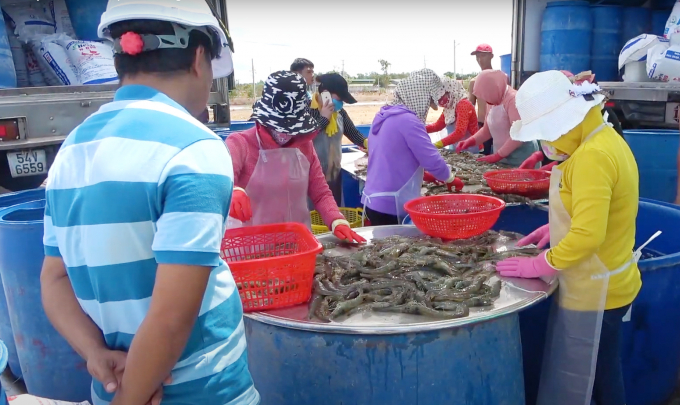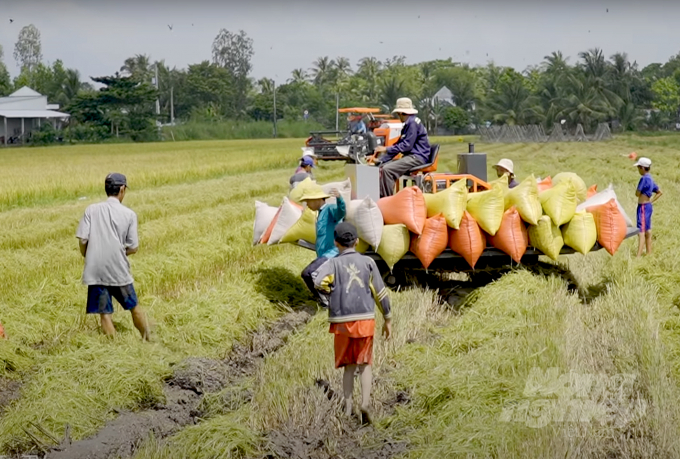May 29, 2025 | 16:07 GMT +7
May 29, 2025 | 16:07 GMT +7
Hotline: 0913.378.918
May 29, 2025 | 16:07 GMT +7
Hotline: 0913.378.918

Shrimp harvesting in Ba Ria - Vung Tau. Photo: Thanh Son.
Vietnamese and European agricultural, food products do not directly compete with one other but instead, they complement each other. Therefore, the EVFTA is opening up great opportunities to promote import and export of agricultural products and food from both parties.
Nguyen Thu Thuy, Deputy Director of the Center for Export Support under the Department of Trade Promotion, Ministry of Industry and Trade, reported that Vietnamese seafood exports to the EU market will reach over 1 billion USD in 2021. This is an increase of 12% compared to 2020. Additionally, exports to most EU state members have increased.
This is a positive result for the first year of implementing the EVFTA and businesses have made good use of the preferential conditions under this Agreement. This figure had the potential to be even higher if Vietnam's seafood production was not interrupted by the Covid-19 pandemic in the third quarter of 2021.
The Vietnam Association of Seafood Exporters and Producers reported that seafood exports to the EU in the first half of this year grew strongly. By the end of May, seafood exports to this market has reached 562 million USD, an increase of 45% over the same period last year.
VASEP said that despite the global high inflation rate, seafood exports to the EU still grew strongly in the first half of the year owing to the significant impact of the EVFTA. Since this Agreement entered into effect, many tariff lines for Vietnamese seafood exports to the EU have been eliminated, making Vietnamese seafood more competitive in price when compared to other sources on the market.
According to Ms. Nguyen Thu Thuy, the EU is currently the second largest market for cashew exports from Vietnam, accounting for 23% of the total export volume and 22% of the total export value of the entire cashew industry. Cashew exports to the EU market reached 135 thousand tons in 2021, equivalent to 816 million USD; this is an increase of 16.5% in volume and 7.9% in value compared to 2020.
The growth of cashew exports to the EU in the last year also was also the result of the EVFTA when the tariffs on processed cashew products from Vietnam into the EU was reduced to 0% immediately after the Agreement came into effect on August 1, 2020. This reduction is significant because before the EVFTA, the tariff on cashew imports into the EU from Vietnam ranged from 7% to 12%.
Rice exports to the EU also increased sharply in the first few months of 2022. According to the Ministry of Industry and Trade, Vietnam exported 15,500 tons of rice to the EU market in the first two months of 2022, equivalent to 11.7 million USD, up by nearly 4 times in volume and 4.3 times in value over the same period in 2021. In the EU, Italy took the lead in Vietnam's rice import market with an increase of 26 times over the same period in 2021. In addition, there are a several other key markets including Germany, France, the Netherlands, and so on.
While the national average rice export price in the first two months of the year decreased by 12.1% to an average of 469 USD per ton, Vietnam's rice export price to the EU still recorded an increase of 9% to an average of 755 USD per ton.

Rice harvesting in Long An. Photo: Minh Sang.
The price of Vietnamese rice exports to the EU market is higher than the national average because the rice exports to this market consist mainly of fragrant rice with high value. Despite the sharp increase in price, the price of Vietnamese rice exports to the EU is still quite competitive compared to other competitors such as Cambodia, Thailand, and India thanks to the EVFTA.
According to VASEP, Vietnamese shrimp exports to the EU reached 303 million USD in the first 5 months of 2022, an increase of 51% over the same period in 2021 and accounting for 54% of the total seafood export value to this market. The 3 largest markets for Vietnamese seafood in the EU include the Netherlands, Germany and Belgium, all of which have seen a strong increase (58-91%) in the value of shrimp exports from Vietnam in the first 5 months of 2022.
In addition to the advantages brought by the EVFTA Agreement, the Russia-Ukraine conflict as well as the sanctions imposed by the EU and US on Russia are creating more opportunities for Vietnamese agricultural products.
The EU is Russia and Ukraine's main trading partner in agricultural products, food and seafood. As a result, this market is facing the risk of shortage of many important food products. Ms. Ta Ha, VASEP's pangasius market expert, said that the fact that many EU and US countries are sanctioning Russian pollock has caused the supply of white fish in this region to plummet.
Russia is the largest pollock producer in the world. Data from the Groundfish Forum shows that, an estimated 49 percent of global pollock catches in 2022 comes from Russia. Russian pollock is a product that competes strongly with the pangasius in the EU white fish market. Therefore, the shortage of pollock supply due to the sanctions imposed on Russia is a good opportunity for Vietnamese pangasius businesses to promote frozen pangasius exports to the EU.
The results of exporting pangasius to the EU in the first half of 2022 has proven this hypothesis. In the first 5 months of this year, pangasius exports to the EU grew remarkably by 89%, reaching nearly 89 million USD.
Conversely, the EVFTA is also creating favorable conditions for many EU agricultural and food products to enter the Vietnamese market, especially livestock products such as meat and dairy.
According to the General Department of Customs, Vietnam imported 36.78 thousand tons of fresh chilled and frozen pork in the first 5 months of 2022, with a value of 77.5 million USD. Germany and the Netherlands are among the 5 largest pork export markets to Vietnam.
In the first half of this year, pork imports into Vietnam fell significantly compared to the same period last year, but imports from Germany and the Netherlands increased sharply. As a result, in the first 5 months of the year, Germany became the third largest pork export market to Vietnam, accounting for 17.5% of total pork imports; The Netherlands ranked 5th with a market share of 3.8%.
The EU is currently one of the leading markets in exporting milk and dairy products to Vietnam. In the first 6 months of 2021, milk and dairy products from the EU reached 96 million USD, accounting for 15% of the total value of imported milk. Many EU countries are among the largest dairy export markets to Vietnam such as Germany, France, etc.
Many EU agricultural products, food and beverages are also having many opportunities to enter the Vietnamese market thanks to incentives from the EVFTA such as fruit, wine, etc. A higher level of income is driving the demand for imported fruits (especially temperate fruits such as apples, pears among others), wine in Vietnam. These are coincidentally EU countries' strengths.
According to the Department of Trade Promotion (Ministry of Industry and Trade), shellfish exports to the EU market in 2021 increased sharply by 37% compared to 2020, reaching 87 million USD. Namely, the main product, clam, increased by 42% and reached 78 million USD. Clams have now become the fourth largest seafood product in export value to the EU market. Clam exports to the three largest markets in EU, Spain, Italy and Portugal, all increased by 38-44%.
Translated by Nguyen Hai Long

(VAN) Vikas Rambal has quietly built a $5 billion business empire in manufacturing, property and solar, and catapulted onto the Rich List.

(VAN) Available cropland now at less than five percent, according to latest geospatial assessment from FAO and UNOSAT.

(VAN) Alt Carbon has raised $12 million in a seed round as it plans to scale its carbon dioxide removal work in the South Asian nation.

(VAN) Attempts to bring down the price of the Japanese staple have had little effect amid a cost-of-living crisis.

(VAN) Fourth most important food crop in peril as Latin America and Caribbean suffer from slow-onset climate disaster.

(VAN) Shifting market dynamics and the noise around new legislation has propelled Trouw Nutrition’s research around early life nutrition in poultry. Today, it continues to be a key area of research.

(VAN) India is concerned about its food security and the livelihoods of its farmers if more US food imports are allowed.